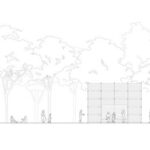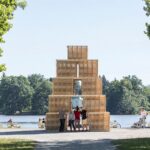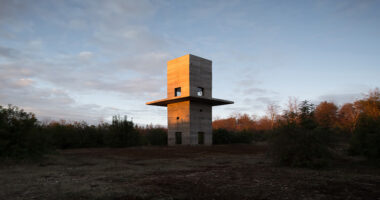In the heart of Kassel’s Karlsaue park, Christoph Hesse Architects unveils the Kollektiv Pavilion—a thought-provoking installation designed for Documenta fifteen, a prestigious global art exhibition. This Reflecting Point serves as a sanctuary for contemplation and dialogue on the critical issue of biodiversity.
A Sanctuary for Reflection
Situated amidst the verdant landscape of Karlsaue, the Kollektiv Pavilion offers visitors a serene space to pause and ponder. Designed as an open-air pavilion, it invites individuals to engage in meaningful conversations and contemplation, fostering a deeper understanding of the natural world.

Complementing Nature: The Concept of Kollektiv
The Kollektiv Pavilion is intricately linked to the nearby installation, Maria, serving as a complementary response. It features Hordengattern (horde gates) and wooden fences meticulously arranged to safeguard young trees within mixed woodlands. This symbiotic relationship between art and nature underscores the installation’s ecological significance.

Protecting Biodiversity: The Purpose of the Wooden Fences
The stacked wooden fences of the Kollektiv Pavilion serve a dual purpose: to protect young plants from wildlife interference and to facilitate the growth of an ecologically diverse forest. When vertically aligned and interconnected, these fences form an 850-meter-long barrier capable of safeguarding up to 5,000 trees, nurturing the biodiversity of the surrounding environment.

Embracing the Poetic Cycle of Nature
In a poetic twist, the wooden fences fulfill their duty over 8 to 10 years, safeguarding the vulnerable saplings until they mature. As the trees reach maturity and the canopy flourishes, the decomposing fences seamlessly integrate with the forest floor, enriching the soil and perpetuating the cycle of growth and decay.

Bridging Art and Ecology
The Kollektiv Pavilion transcends conventional notions of art and architecture, serving as a bridge between human creativity and the natural world. Through its innovative design and ecological stewardship, it embodies the spirit of collaboration and collective responsibility, inspiring visitors to cherish and protect our planet’s biodiversity.
In essence, the Kollektiv Pavilion stands as a testament to the power of art to provoke thought and evoke change, urging us to reflect on our relationship with nature and embrace sustainable practices for the generations to come.

























